Published 16:59 IST, July 11th 2021
Korean war: Seoul commemorates India’s paratrooper Lt Col AG Rangaraj as 'War Hero'
Photographs of commander of the 60th Parachute Field Ambulance of the Indian Army were displayed at various locations including the Korean War Memorial

As Seoul marked the 71st anniversary of the Korean War (June 1950 to July 1953), it honoured India’s first paratrooper Lt Col AG Rangaraj as the ‘Korean War Hero For the Month’ on July 10. Photographs of the then commander of the 60th Parachute Field Ambulance of the Indian Army were displayed at various locations including the Korean War Memorial to commemorate his significant contribution as he had treated more than two lakh war casualties during the Korean conflict. Seoul revisited India’s much-overlooked but significant role in accelerating the United Nations (UN) led resolution to bring the conflict to end.
The country highlighted the less talked about efforts of India’s Permanent Representative to the United Nations and its constraining role at the UN just 3 years into the independence in brokering peace process the ‘Korean Armistice Agreement’ which was signed on July 27, 1953, even when the United States had a dominant voice. The war started on June 25, 1950, involving South Korea and the Western alliance, led by the US under a UN resolution known as the UN Command as well as a Socialist alliance of North Korea and China known as the Korean People’s Army and the Chinese People’s Volunteers supported by the Soviet Union.
The Indian Army’s medical unit played a unique role in providing assistance to the South Korean soldiers as they attended to the war victims in the conflict-stricken fields as a humanitarian gesture. At the time, India’s 60 Para Field Ambulance or the 60 Para was commanded by Lieutenant Colonel AG Rangaraj which included four combat surgeons, two anesthesiologists, one dentist and an estimated total of 346 men that helped South Koreans with medical aid.
“Remembering India’s help and support as a friend, when we were in difficult times, is very important for us. We feel obligated to teach this to both countries’ young generations. History should be maintained, taught and properly promoted continuously for the next generation. We hope that more people get interested and study more about this point — the historical relation between Korea and India,” said Hwang Il-Yong, Director of Korean Culture Centre India in a release on July 10.
Indian army treated 195,000 casualties
On Saturday, Seoul commemorated the members of the Indian medical troop by displaying 32 photographs at an online exhibition titled “Korean War Special Exhibition: 60 Para Field Ambulance”. One of the pictures portrays Edwina Mountbatten, Countess Mountbatten of Burma, visiting the 60 Para Field Ambulance, while another showed troops at the Gloster Valley and one other depicted Indian medical team crossing water hurdles as they were left with no transport initially. Pictures highlighted the efforts of soldiers treating civilians at Munsan Falls and the war casualties at the Daegu Hospital. In total, the Indian army treated 195,000 casualties and performed nearly 2,300 field surgeries while Indian representatives debated policies in bringing the conflict to a speedy conclusion.
India delivered overcoming the complexities, as the NNRC headed by India headed by Lt Gen. S Thimayya with the help of Custodian Forces of India (CFI) also gathered 170,000 non-repatriated prisoners of wars held by the UN forces. China demanded forceful repatriation of the prisoners while India stood for human rights under the Neutral Nations Repatriation Commission (the NNRC). The mission led by India in compassion had just 100 war captured who refused to be repatriated to either South or North Korea. Those were allowed to come to India once the NNRC and CFI concluded operations.
Updated 16:59 IST, July 11th 2021




